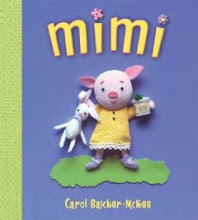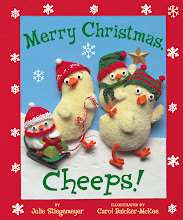My goodness, there has been a lot of Christmas-time paper cutting at my house over the years! Here are some more paper cuts that we've done in years past - some by my kids, some by me - mostly with a snow/winter theme. I'll add some tips for making your own.
The snowmen above were part of a large quantity of paper bag papercuts we made one year to adorn our packages, which were wrapped with either plain white or plain red paper. One of my kids did the cutting for the one above, following a free hand drawing I did on the back side of the paper. It was cut on a fold (sort of paper doll chain style, only with just a single repeat). I reused the lightweight paper bags the kids took their lunches in - they have enough body/stiffness to cut cleanly, but are light enough for small hands to get the scissors through two layers easily. The eyes and buttons were made with a standard circle hole punch. I let all my kids graduate to real scissors (often Fiskars embroidery scissors) at a relatively young age (6 or 7) and just supervised their cutting. No one ever got hurt, not even a smidge, though my guys did not have especially good fine motor skills. (I think kids are sometimes more careful when they're using real tools - and the results are definitely superior.)
The house above is basically the same method, but a single picture with no fold/repeat. Also cut by a child (though I may have cut the windows - don't recall). For interior cuts (like the windows and door), I usually (re)folded the paper so the kids didn't have to poke scissors into the middle of the paper to get the window or whatever started. Afterwards, I ironed the paper cuts on a low setting to get out the folds. (You can even mist kraft paper lightly to steam it and make it smoother.)
What I like about it is that the polar bear is a negative - I cut away part of the blue paper to leave the figure. The moon and stars are also negatives. It's somewhat trickier thinking the drawing through - and also harder to cut (you have to be careful not to cut away the lines of the legs and make an effort to keep the lines thin enough), but going slowly and holding the thin unconnected bits with a fingernail to stabilize them as you cut are the keys. I start first with the small interior cuts, like the space between his hind feet and the rearward front leg - it's easier to do those while the paper is still mostly whole. Then I cut the edges of the lines for the legs before cutting away the rest of the interior bear. Last I cut away for the snow and forming the outer edges of the polar bear's legs.
The shadow is a piece of gray paper added separately - though obviously I didn't think through the direction the moonlight would cast it!
This was also our Christmas card one year - made by my oldest when he was in kindergarten. We planned the picture together - and what was notable was his idea not to show the whole person, just part. That's an unusual approach for a child that age - but it shows the value of sharing good art and talking about it with your children. Just before we made this, we visited the Carnegie Museum of Art here in Pittsburgh. I have forgotten which painting served as his inspiration, but I clearly remember our discussion about cropping images and choosing what to show and what to leave out.
He cut the snowflake freehand (I folded the paper for him first). Making snowflakes was a constant winter activity for my kids in those days. Then he cut out the shapes for the mitten, sleeve, face and hats from white paper following lines I helped him draw on white printer paper. He also cut fringes from black construction paper for the hair and shirt cuff and we glued everything onto another piece of black paper. I cut the curves for the eyes and nose, and he made circles for the pupils with a paper punch. To make the cards and gift tags, I photocopied the image, reducing it to a variety of sizes and ganging them onto a single sheet so I could print a bunch at a time. This was pre-photoshop years! We cut and pasted the images manually onto white cards or manilla tags. They looked pretty sophisticated for a five-year-old's work.

The images above and below were cut by me from silhouette paper, using a craft knife. They look challenging (and were, because the originals were fairly small - but carefully planning and working slowly are again the keys to success.
Real silhouette paper is nice to work with - a good weight and reasonably strong. You can buy it here. For these kinds of images, I draw the image on vellum tracing paper with a soft drawing pencil (like an Ebony pencil - love those guys) because they make nice thick lines that are easy to leave behind as I cut. It's best to use a slightly dull pencil. I then turn the drawing upside down onto the back (white side) of the silhouette paper and transfer the image with a wooden stylus. This means the final image will have reversed back to the same as your drawing. Be careful not to press too hard or the lines will show through on the final silhouette.
I like how the pinecone and some of the needles "violate" the borders in these. I always like that in book illustrations too. The illustrator Tomi Ungerer often had elements in his pictures violating the borders.
You can often reattach bits you've accidentally cut away by taking a thin scrap and gluing it to the back side of the main piece and the cut away part. Touching up with a little permanent black ink will hide any telltale white lines.
Below is a Santa cut by my son when he was nine or ten. I did the drawing, and he did the cutting using embroidery scissors and silhouette paper. I cut the black frame for him with a craft knife - it gives the work a nice finished appearance, I think.
My son wanted to make a Santa holding a star like the one in this charming, quirky vintage Christmas book first published in 1956. It's by Mary Chalmers, one of my all time favorite writer-illustrators.
Unfortunately, the original, which was lovely and just the right size for small hands, belonged to that same younger sister, and I wasn't able to steal it away once we were grown. For years I tried in vain to track down a copy of my own - luckily it was reprinted a while back, though in a larger, glossier format I just don't like nearly as much.
Sigh. Books like this that were scarce before CPSIA have only become rarer still. But if you want an old copy, you can hunt for one on sites like Amazon, Alibris and AbeBooks.
I'll leave you with one last snowflake blizzard - arranged into a wreath one year to fill the space above my mantle until I could come up with some art to put there. (We'd just taken down the damaged mirror that was there before and repaired the wall.) I think I got the idea from a magazine. (Martha Stewart?)



















































